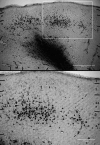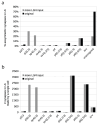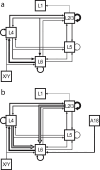A strong direct link from the layer 3/4 border to layer 6 of cat primary visual cortex
- PMID: 38753019
- PMCID: PMC11176106
- DOI: 10.1007/s00429-024-02806-3
A strong direct link from the layer 3/4 border to layer 6 of cat primary visual cortex
Abstract
The cat primary visual cortex (V1) is a cortical area for which we have one of the most detailed estimates of the connection 'weights' (expressed as number of synapses) between different neural populations in different layers (Binzegger et al in J Neurosci 24:8441-8453, 2004). Nevertheless, the majority of excitatory input sources to layer 6, the deepest layer in a local translaminar excitatory feedforward loop, was not accounted for by the known neuron types used to generate the quantitative Binzegger diagram. We aimed to fill this gap by using a retrograde tracer that would label neural cell bodies in and outside V1 that directly connect to layer 6 of V1. We found that more than 80% of labeled neurons projecting to layer 6 were within V1 itself. Our data indicate that a substantial fraction of the missing input is provided by a previously unidentified population of layer 3/4 border neurons, laterally distributed and connecting more strongly to layer 6 than the typical superficial layer pyramidal neurons considered by Binzegger et al. (Binzegger et al in J Neurosci 24:8441-8453, 2004). This layer 3/4 to layer 6 connection may be a parallel route to the layer 3 - layer 5 - layer 6 feedforward pathway, be associated with the fast-conducting, movement-related Y pathway and provide convergent input from distant (5-10 degrees) regions of the visual field.
Keywords: Cat; Cortical circuit; Interlaminar connectivity; Striate cortex; Visual system.
© 2024. The Author(s).
Conflict of interest statement
The authors have no relevant financial or non-financial interests to disclose.
Figures









Similar articles
-
Dynamic Recruitment of the Feedforward and Recurrent Mechanism for Black-White Asymmetry in the Primary Visual Cortex.J Neurosci. 2023 Aug 2;43(31):5668-5684. doi: 10.1523/JNEUROSCI.0168-23.2023. Epub 2023 Jul 24. J Neurosci. 2023. PMID: 37487737 Free PMC article.
-
Form, function and intracortical projections of spiny neurones in the striate visual cortex of the cat.J Physiol. 1984 Aug;353:463-504. doi: 10.1113/jphysiol.1984.sp015347. J Physiol. 1984. PMID: 6481629 Free PMC article.
-
Distinct balance of excitation and inhibition in an interareal feedforward and feedback circuit of mouse visual cortex.J Neurosci. 2013 Oct 30;33(44):17373-84. doi: 10.1523/JNEUROSCI.2515-13.2013. J Neurosci. 2013. PMID: 24174670 Free PMC article.
-
Understanding layer 4 of the cortical circuit: a model based on cat V1.Cereb Cortex. 2003 Jan;13(1):73-82. doi: 10.1093/cercor/13.1.73. Cereb Cortex. 2003. PMID: 12466218 Review.
-
A numerical analysis of the geniculocortical input to striate cortex in the monkey.Cereb Cortex. 1994 May-Jun;4(3):215-29. doi: 10.1093/cercor/4.3.215. Cereb Cortex. 1994. PMID: 8075528 Review.
References
-
- Anderson JC, Martin KAC. Chap. 6 - interareal connections of the Macaque cortex: how Neocortex talks to itself. In: Rockland KS, editor. Axons and Brain Architecture. San Diego: Academic; 2016. pp. 117–134.
MeSH terms
LinkOut - more resources
Full Text Sources
Miscellaneous

